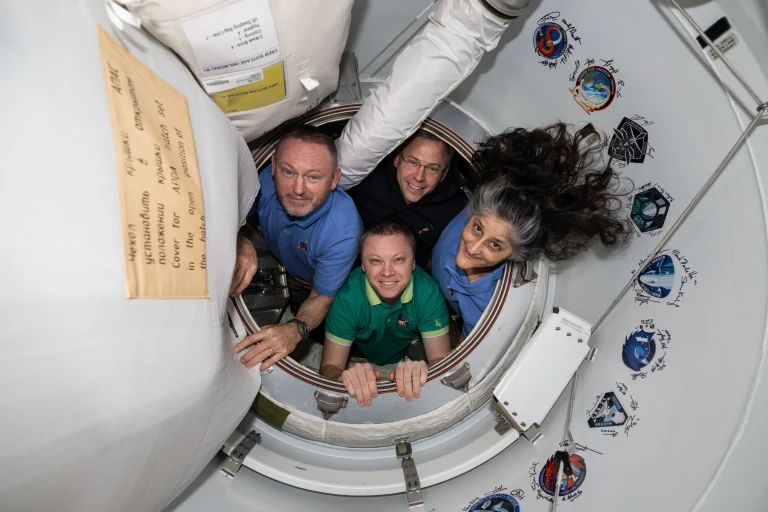We’re celebrating National Aviation Day! After all, we are the National Aeronautics and Space Administration. Aviation and aeronautics are as much a part of our mission as space travel.
This visualization is generated from a supercomputer simulation of the X-57 “Maxwell” electric experimental aircraft. Just as electric cars are becoming more and more commonplace on our roads each day, aerospace engineers are seeking to make electric air transportation a reality. In pursuit of that goal, NASA is developing its first crewed X-plane in more than 20 years. Compared with conventional aircraft, the X-57 team has set a goal of using five times less energy and – if powered by electricity generated from renewable sources – producing zero inflight carbon emissions.
The X-57’s unique propulsion system, in its final configuration, features 14 battery-powered electric motors and propellers: 12 to provide lift during takeoff and landing, and one at the tip of each wing to provide forward thrust during flight. In order to understand the aerodynamic effects of this design, a team of engineers from three NASA centers – Ames Research Center in California’s Silicon Valley, Langley Research Center in Hampton, Virginia, and Armstrong Flight Research Center in Edwards, California – is using supercomputers to simulate flight conditions for the X-57.
The moment simulated here is from the cruise phase of flight, with pressure shown on the aircraft surface (maroon: high pressure, dark blue: low pressure) and streamwise velocity, or the speed and direction of air flowing toward the aircraft, near the X-57’s rightmost propeller (top left of image; red: high velocity, green/blue: lower velocities).
These simulations help the team analyze the aircraft’s stability and its ability to stay in flight and change direction and will also allow them to create an accurate computer model of aerodynamic performance to incorporate into the X-57 flight simulator.
By accurately predicting the impacts of the X-57’s propulsion system, the aerodynamic model ensures that its flight simulator performs in a manner consistent with actual flight and lets pilots test emergency scenarios and safe recovery measures. Run on the Pleiades supercomputer at the NASA Advanced Supercomputing facility at Ames, the simulations are helping take the next step toward a cleaner way to fly.
Image Credit: NASA/Ames Research Center/J. Duensing
Text Credit: Michelle Moyer, NASA Advanced Supercomputing Division
我们正在庆祝国家航空日!毕竟,我们是国家航空航天局。航空航天与太空旅行一样,也是我们使命的一部分。
这张可视化图是由超级计算机模拟生成的X-57“麦克斯韦”电子实验飞机。正如电动汽车每天在我们的道路上变得越来越普遍一样,航空航天工程师们正在寻求使电动航空运输成为现实。为了实现这一目标,NASA正在开发20多年来的第一架载人X-Plane。与传统飞机相比,X-57团队设定了一个目标,即将能源消耗减少五倍,并且,如果使用可再生资源产生的电力,则可实现零机上碳排放。
X-57独特的推进系统在其最终配置中具有14个由电池供电的电动机和螺旋桨:12个在起飞和降落时提供升力,在每个机翼的尖端提供一个在飞行过程中提供向前推力。为了了解这种设计的空气动力学效果,来自三个NASA中心的工程师团队-加利福尼亚硅谷的艾姆斯研究中心,弗吉尼亚州汉普顿的兰利研究中心和加利福尼亚州爱德华兹和阿姆斯特朗飞行研究中心-正在使用超级计算机来模拟X-57的飞行条件。
这里模拟的时刻来自飞行的巡航阶段,飞机表面显示的压力(栗色:高压,深蓝色:低压)和流向速度,或空气流向飞机的速度和方向,靠近X-57的最右边的螺旋桨(图像左上角;红色:高速,绿色/蓝色:低速)。
这些模拟帮助团队分析飞机的稳定性、保持飞行状态和改变方向的能力,也将允许他们创建一个精确的空气动力学性能的计算机模型,以纳入X-57飞行模拟器。
这些模拟运行在位于埃姆斯(Ames)的NASA高级超级计算设施的Pleiades超级计算机上,有助于朝着更清洁的飞行方式迈出下一步。
影像来源:NASA/Ames Research Center/J. Duensing
文字来源:Michelle Moyer, NASA Advanced Supercomputing Division








将可再生能源早日运用到航空领域对未来航空器的发展将有变革性意义。